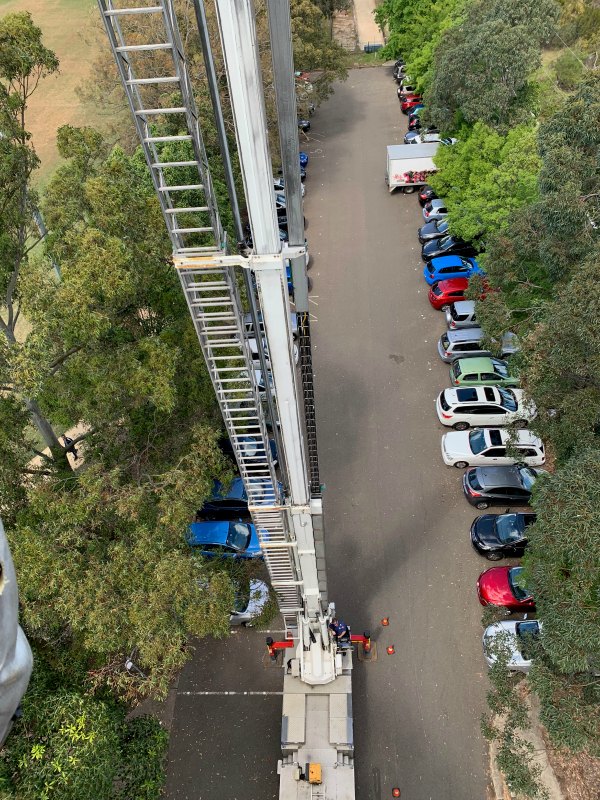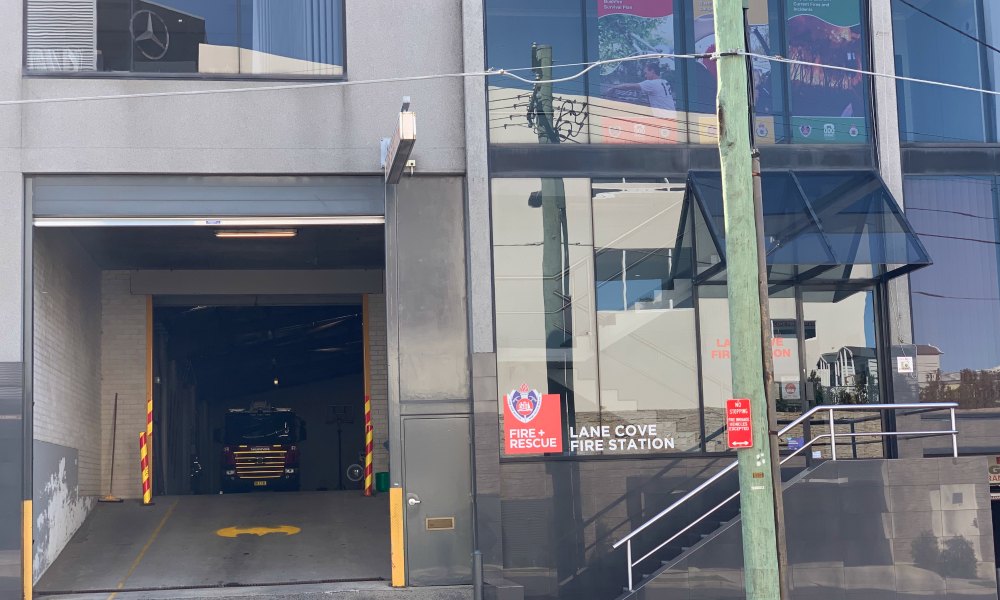Lately, Lane Cove has been keeping our emergency services busy. Lane Cove Fire and Rescue are usually the first responders to an incident in the Lane Cove Council area. ITC contacted NSW Fire and Rescue and asked if we could shadow a team from the Lane Cove Fire and Rescue station.
The idea was to write an article on a typical day at the Lane Cove Fire and Rescue Station. ITC soon found out, that unless I wanted to sleep at the fire station, this would not be possible. Full time firefighters now work a 24-hour shift. The shift starts at 8.00 am and finishes 24 hours later. ITC did however spend several hours with Lane Cove Fire and Rescue Team D and it was an eye opener!
Lane Cove Fire and Rescue Unit
Lane Cove Fire and Rescue is located in Artarmon.
The station has 4 teams each with 4 team members who work a 24-hour shift. The Lane Cove Fire and Rescue area extends from Artarmon right up to Lindfield. However if they are on the road they can be called out to any area. For example, while ITC was with the team, they were called to a fire in Neutral Bay.
During a shift the crew will responds to calls, check equipment, clean the station, visit schools, help local elderly residents and sleep (but they very rarely get to sleep for an extended period).
ITC is not sure if we could do a 24-hour shift, but the crew seemed to like it. It allows them to be more involved with the community, lessens commuting time and gives them a better work/life balance. The crew works a 24-hour shift, has a day off, works another 24-hr shift and then has 5 days off.
Team D crew is David, Monty, Johann and Adam.
ITC’s Day with Lane Cove Fire and Rescue
8.00 am – ITC arrives for our “shift” with the Team D Lane Cove Fire and Rescue (they are already on a job and not at the station).
8.20 am – Team D arrives back at station.
8.52 am – Team D called out to an apartment block in Artarmon. On the way to the call, station manager David has his iPad and he is working out what they need to do and where the fire alarm board is located.
While the team check out the fire alarm, Monty the driver, gets busy at the site. He locates the water main and has it ready to go. When he is told it is a false alarm, he puts the cover back and then spray paints it yellow, so that it easy to find next time they are called out.
Two fire trucks (or as ITC now knows they are called Pumps) attend each fire alarm call out.
It’s a false alarm triggered by some contractors working on the building’s roof.
9.30 am – Team D returns to the station and starts an equipment check and cleans the station.
10.00 am – Team D called out to the St Leonards TAFE. It was a false alarm in the cafeteria.
10.30 am – Training Session at local park organised with the Fire and Rescue Crows Nest Station. The Lane Cove and Crows Nest stations have a close working relationship. Crows Nest is also a Rescue station with sophisticated rescue equipment and specially trained rescue staff. Just as the teams are about to start the training session both teams are called out on different jobs.
While the teams are away (at yet another false alarm), ITC is lucky enough to be involved in a training drill with the Crows Nest Rescue team and their Bronto Skylift. The Bronto Skylift provides an aerial platform to reach people trapped in high rise apartments. The Bronto Skylift can reach up to 40 metres. ITC is happy to go up to 30 m.

The purpose of this exercise was to manoeuvre the Bronto in a tight space near trees. ITC was not scared at all as we knew we were in safe hands.

12.30 pm The training session is completed. It’s time for lunch. On our way back from the training session we stop at the Lane Cove shops for lunch. Many times they order lunch but have to leave before it’s ready to go on a job. It does not matter where they are or what time it is, they are always on call.
1.00 pm We are back at the station and for the first time that day there is time sit down and talk while we eat lunch. The crew tells ITC they are spending more and more time assisting with motor vehicle rescues and providing medical assistance (ITC visited the fire station just days after Lane Cove Fire crews was called out two nights in a row to attend major accidents on River Road Greenwich).

Lane Cove Fire and Rescue teams also assist seniors and people with a disability by installing battery-operated smoke alarms or replacing existing smoke alarm batteries at no cost (see details on the SABRE Programme below).
Locals can also arrange a fire safety visit. This visit assists people to reduce their risk of an accidental fire in their home (see details on Safety Visits below).
Educating the community on fire safety is a big part of their work. Recently the team spent a day at St Michaels Primary School educating the kids on what to do if their home is on fire.
ITC asked if they really do rescue cats, dogs and birds stuck in trees or wall cavities. The answer is yes. They also assist when a person gets their hand stuck in a drain (usually trying to retrieve a wedding ring).
1.30 pm – Rescue Training session at the Crows Nest Fire and Rescue Station. Five minutes into the training session both teams are called out for another false alarm.
1.50 pm – The teams return and undertake further training on responding to motor vehicle accidents and how to safely access and assist an injured person trapped in a motor vehicle. At the Crows Nest Station ITC bumps into a long time ITC follower. Tol is a fire fighter who has lived in Lane Cove for years. We took a picture of Tol when he was grabbing lunch at Lane Cove and it’s probably still one of our most popular posts!!

2.45 pm – The team returns to the Lane Cove Fire and Rescue station. ITC is exhausted and needs to go home. Team D will be there until 8.00 am the next morning. ITC leaves the team as they sit down and start the trivia quiz in the paper. The guys are also avid watchers of ABC 24-hour news and enjoy the National Press Council talks. Later (if they have time) they will also try and fit in some gym work. Each station has gym equipment. Being fit is a crucial part of the job.
Thank you to Monty, Adam, Johann and team leader David for letting ITC follow them around. They never stopped the whole day. Also a big thank you to the team at Fire and Rescue Crows Nest. ITC got the feeling that if the Lane Cove Fire and Rescue station could have one wish, they would like to be located in Lane Cove. When attending a fire, every second counts and having to navigate there way around the Artarmon industrial area and across the Pacific Highway is difficult and dangerous.
What is the SABRE Program?
The Smoke Alarm and Battery Replacement (SABRE) program assists seniors and people with a disability who are vulnerable in the case of a fire because they are not able to install and/or maintain their smoke alarms.
Firefighters can visit a residence at an arranged time to install a battery-operated smoke alarm or replace existing smoke alarm batteries at no cost. The resident must supply the battery-operated smoke alarm or batteries. Firefighters can provide home fire safety advice while visiting premises.
Residents who have limited domestic support (no access to family, friends or neighbours who can assist) and are living in their own or privately rented home in FRNSW fire district are eligible for the program.
Examples are:
* frail aged people (aged over 65),
* people with disabilities, or
* people who are already receiving community assistance and services.
To access this programme, eligible residents should contact the Lane Cove Fire and Rescue fire station on an annual basis to get assistance. If your smoke alarm ‘chirps’ earlier, this may indicate a low battery level.
The Lane Cove Fire and Rescue phone number is 9901 2420
What is a Safety Visit and How Do I Organise One?
Having a working smoke alarm in conjunction with a home escape plan will greatly increase your chances of getting out safely if a fire occurs in your home. Every second counts.
A Safety Visit assists people to reduce their risk of an accidental fire in the home and to safely escape in the event of a fire occurring.
During a Safety Visit, firefighters will attend a home and check that there are working smoke alarms, that they are in good working condition, and are installed in suitable areas. If you do not have one, firefighters will install a long-life battery-powered smoke alarm as well as replace existing smoke alarm batteries all at no cost.
With your permission, firefighters will also ask you to show them around your home and property.
This will allow them to give you personalised fire safety information including:
bedroom heating and wheat bags
Firefighters will also provide advice on a fire escape plan in the event of a fire occurring in your home and how to call Triple Zero (000) to report emergencies.
If you or someone you know would benefit from a Safety Visit, please contact Lane Cove Fire and Rescue on 9901 2420.
Everyone can benefit from a Safety Visit, however there are people within our community that are statistically at higher risk of incidents occurring, including:
- Over 65’s.
- Those who live alone.
- People with limited mobility, hearing impairments or vision impairments.
- Residents who are supported by carers, family and friends.
- And anyone with English as a second language.
Facts about NSW Fire and Rescue
Fire and Rescue NSW has 335 fire stations across NSW.
They protect 90% of the State’s population from emergencies involving fire, motor vehicle accidents and other dangerous situations.
They protect 100% of the State’s population from hazardous materials emergencies and building collapse.
They provide terrorism consequence management for 100% of the State.
Fire and Rescue NSW plays an important role in building safety, both legislatively and as a community service.
They develop and deliver a range of community safety initiatives and prevention programs including, FireEd (Fire Education for Primary Schools), IFAP (Intervention and Fire Awareness Program for juvenile firesetters) and more.
In the Cove is In the Know and you could be as well…
In the Cove publishes new content every day. It could be an article, an event, a job or local info. To make sure you don’t miss this info sign up to our newsletter. It comes out every Wednesday Night at 7.30pm and includes a wrap up of every article published in the previous week and local events for the next seven days.
Read this week’s newsletter
Did you know that In the Cove has an instagram page? Yes we do and we feature pictures from our roving reporters and our ITC team that do not appear on our Facebook page. Follow us on @inthecove



















